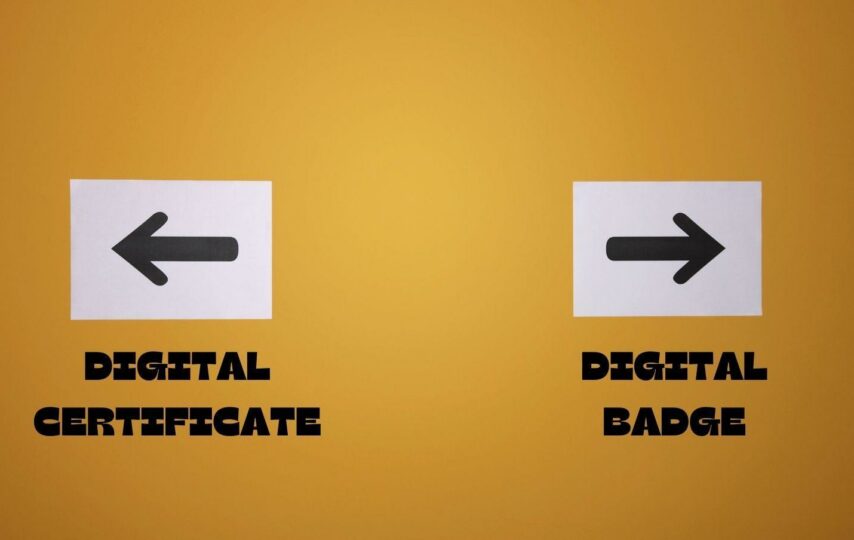In today’s digital age, credentialing and skill validation have undergone a significant transformation. Traditional paper-based certificates are being replaced by their digital counterparts, offering greater accessibility, versatility, and efficiency.
Among these digital credentials, two prominent forms stand out: digital badges and digital certificates. While they both serve the purpose of recognizing achievements and skills, there are distinct differences between the two. In this article, we will delve into the characteristics, purposes, features, and applications of digital badges and digital certificates, providing a comprehensive understanding of their disparities.
Defining Digital Badges and Digital Certificates
Digital badge is a visual representation of an achievement or skill earned by an individual. It typically contains metadata that provides information about the issuer, criteria for earning the badge, and evidence of the accomplishment. Digital badges are often displayed on online platforms, such as social media profiles, websites, or digital portfolios, allowing individuals to showcase their achievements to a wider audience.
Digital certificate, on the other hand, is a secure digital document that verifies an individual’s completion of a specific course, program, or assessment. It includes information such as the individual’s name, the name of the issuing organization, the date of completion, and any relevant accreditation or standards met. Digital certificates are primarily used for formal credentialing and can be shared electronically or printed for physical documentation.
Purposes and Use Cases
Digital badges serve various purposes across different domains. They are commonly used in education to recognize specific skills or achievements within a course or program. For example, in an online coding course, badges can be awarded for completing modules, mastering programming languages, or demonstrating problem-solving skills. Digital badges are also employed in professional settings, where they validate specialized skills, competencies, or accomplishments relevant to a particular field. Additionally, digital badges can foster motivation, engagement, and lifelong learning by providing a tangible and shareable representation of progress and achievements.
Digital certificates are primarily used for formal recognition and accreditation. They are commonly issued by educational institutions, training organizations, or professional associations to validate the completion of a structured curriculum, program, or certification process. Digital certificates carry weight and credibility in the job market, helping individuals stand out to employers and enhancing their professional profiles. They are often required as proof of qualification for employment opportunities, promotions, or further educational pursuits.
Features and Applications
One notable feature of digital badges is their visual and interactive nature. They are designed to be eye-catching and visually appealing, making them easily recognizable and shareable. Digital badges can be embedded with links or metadata that provide additional information about the issuer, criteria, or evidence of achievement. This interactivity allows viewers to validate the authenticity and legitimacy of the badge. Moreover, digital badges can be part of a larger ecosystem, where earning multiple badges unlocks new opportunities or pathways, leading to more advanced credentials or learning experiences.
Digital badges find applications in a wide range of contexts. In education, they can enhance student motivation, engagement, and self-directed learning. Teachers can use badges as a form of micro-assessment, providing timely feedback and recognizing students’ progress. In professional development, digital badges can validate skills acquired through online courses, workshops, or conferences, enabling professionals to showcase their expertise. They can also facilitate networking and collaboration within online communities, as individuals with shared badges can connect based on common interests or achievements.
Digital certificates prioritize validation, verification, and compliance. They are issued by trusted entities and often employ cryptographic technologies to ensure their integrity and security. Digital certificates can be verified through online platforms or certificate registries, allowing employers, institutions, or individuals to confirm their authenticity. Furthermore, digital certificates can be linked to blockchain technology, which provides an immutable record of achievements, enhancing trust and eliminating the risk of tampering or fraudulent claims.
The applications of digital certificates span across diverse sectors. In education, they can be used for formal degree programs, vocational training, or professional certifications. Employers rely on digital certificates to assess job applicants’ qualifications and verify their skills. Government agencies and regulatory bodies can issue digital certificates to ensure compliance with specific standards or regulations. Additionally, digital certificates find use in the healthcare industry, where they validate professionals’ licenses, accreditations, or specializations, ensuring patient safety and quality of care. Platforms like Sertifier make it easier for individuals and organizations to issue, manage, and showcase both digital badges and digital certificates
Conclusion
In conclusion, digital badges and digital certificates are distinct yet complementary forms of digital credentials. Digital badges offer a visual representation of achievements and skills, fostering motivation and engagement, while digital certificates provide formal recognition and accreditation, validating completion of structured programs or assessments.
Understanding the differences between digital badges and digital certificates is crucial for individuals, educational institutions, employers, and organizations to effectively utilize these credentials in the digital landscape. Whether you seek to showcase your accomplishments or assess the qualifications of others, the adoption of digital badges and digital certificates continues to reshape the way we recognize and validate skills in the modern world.
Digital badges are digital documents that visually represent an individual’s achievement or skill. It usually contains metadata that includes badge issuer information, criteria for earning the badge, and evidence of success. Digital badges are often displayed on online platforms such as social media profiles, websites or digital portfolios, allowing individuals to promote their achievements to a wider audience.
Digital certificates, on the other hand, are secure digital documents that confirm that an individual has completed a particular course, program, or assessment. It includes information including the name, the name of the issuing organization, the date of completion, and any relevant accreditation or standards. Digital certificates are often used for official identification and can be shared electronically or physically.








